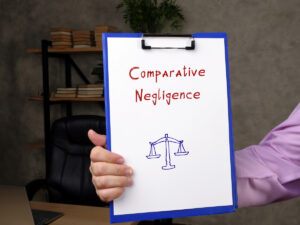 Pennsylvania’s comparative negligence law represents one of the most important concepts for personal injury victims to understand, as it directly determines whether you can recover compensation and how much you may receive. Unlike some states that completely bar recovery if you bear any fault for an accident, Pennsylvania takes a more balanced approach, following a 51 percent comparative negligence rule, which means you can recover damages if you were less than 51 percent at fault. If you are found to carry more than 50 percent of the fault for the accident, you will be unable to receive compensation for damages.
Pennsylvania’s comparative negligence law represents one of the most important concepts for personal injury victims to understand, as it directly determines whether you can recover compensation and how much you may receive. Unlike some states that completely bar recovery if you bear any fault for an accident, Pennsylvania takes a more balanced approach, following a 51 percent comparative negligence rule, which means you can recover damages if you were less than 51 percent at fault. If you are found to carry more than 50 percent of the fault for the accident, you will be unable to receive compensation for damages.
Understanding how Pennsylvania courts assign fault and calculate damages under the comparative negligence rule can mean the difference between substantial compensation and no recovery at all. At Rubin, Glickman, Steinberg & Gifford, we have successfully navigated these complex fault determinations for over 65 years, helping Pennsylvania residents recover fair compensation even when they bear partial responsibility for their accidents.
Types of Cases Affected by Comparative Negligence
Comparative negligence applies to a variety of personal injury cases, including car accidents, slip and falls, and product liability claims. This rule helps distribute fault in cases where multiple parties contribute to the incident. In car accident cases, factors like speeding, distracted driving, or failure to yield can all contribute to fault allocation, even if another driver was primarily responsible for the collision.
Slip and fall accidents often involve comparative negligence analysis when plaintiffs were wearing inappropriate footwear, not watching where they walked, or ignored obvious hazards. Similarly, medical malpractice cases may consider whether patients followed treatment instructions or disclosed relevant medical history. Even in nursing home abuse cases, comparative negligence principles may apply if families failed to communicate important information about a resident’s needs or condition.
Pennsylvania’s Fair Share Act and Multiple Defendants
The Pennsylvania comparative negligence laws go hand-in-hand with the Fair Share Act of Pennsylvania. The Fair Share Act, put into legislation in 2011 as Senate Bill 1131, dictates that defendants can be held liable only for their share of fault. This act usually comes into play when there is more than one defendant. So, the driver who was at 48% fault will only pay 48% of the damages to the injured party, while the other driver will pay 52%. However, if one defendant is found to be 60% or more at fault for the incident, they will be responsible for the entire amount of damages under the Fair Share Act.
This system prevents situations where defendants with minimal fault get stuck paying for the actions of more culpable parties who may be uninsured or unable to pay. However, it also means that if the primary at-fault party lacks sufficient insurance or assets, your recovery may be limited to what each defendant can actually pay based on their fault percentage.
Building Strong Evidence to Minimize Your Fault
An attorney can investigate the accident, consult with field experts such as engineers and accident reconstructionists, help find remaining evidence, and work to establish the other party’s fault and your lack thereof. If the insurer or defendant tries to pin you with undue blame, your attorney can use proof to argue the opposite. To prove comparative negligence in Pennsylvania, the defendant must demonstrate that the plaintiff had some level of fault in causing the accident through meticulous gathering of evidence, encompassing eyewitness testimonies, accident scene photographs, video surveillance, and expert testimonies.
Documentation of injuries through medical records can establish the severity of injuries and whether your actions or those of the other party contributed to worsening them. For instance, not wearing a seatbelt may partially shift fault, even if another driver caused the crash. Early investigation becomes crucial because evidence can disappear quickly, and witness memories fade. The sooner you involve experienced legal counsel, the better positioned you’ll be to challenge unfair fault allegations and protect your right to compensation.
Rubin, Glickman, Steinberg & Gifford: Protecting Your Rights Under Comparative Negligence Law
Pennsylvania’s comparative negligence system creates both opportunities and challenges for personal injury victims. While the law allows recovery even when you share some fault, insurance companies and defense attorneys will work aggressively to inflate your percentage of responsibility and reduce their clients’ liability. Our attorneys understand how to effectively challenge these tactics and present compelling evidence that accurately reflects each party’s role in causing your accident.
We know that successful comparative negligence cases require thorough investigation, strategic use of expert witnesses, and skilled presentation of facts that minimize our clients’ fault while establishing the defendant’s primary responsibility. Our recognition as a “Best Law Firm” by U.S. News & World Report every year since 2010 reflects our ability to achieve favorable results even in complex fault scenarios. If you’ve been injured and face questions about shared responsibility, contact us today at (215) 822-7575 or through our online contact form to learn how we can protect your rights under Pennsylvania’s comparative negligence laws.

Rubin, Glickman, Steinberg & Gifford P.C.
Pennsylvania Attorney's
October 1, 2025









